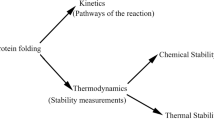Abstract
The fundamental law for protein folding is the thermodynamic principle. The amino acid sequence of a protein determines its native structure and the native structure has the minimum Gibbs free energy. Lacking of a Gibbs free energy formula is the reason that all ab initio protein structure prediction only empirical and various empirical energy surfaces or landscapes are introduced to fill the gap. We make a quantum mechanics derivation of the Gibbs free energy formula G(X) using quantum statistics for a single conformation X. For simplicity, only monomeric self folding globular proteins are considered.
Similar content being viewed by others
References
Bryngelson J D, Onuchic J N, Socci N D, et al. Funnels, pathways, and the energy landscape of protein folding: A synthesis. Proteins, 1995, 21: 167–195
Bader R F W. Atoms in Molecules: A Quantum Theory. Oxford: Clarendon Press, 1990. 130
Richards F M. Areas, volumes, packing, and protein structure. Ann Rev Biophys Bioeng, 1977, 6: 151–176
Lee B, Richards F M. The interpretation of protein structures: Estimation of static accessibility. J Mol Biol, 1971, 55: 379–400
Anfinsen C B. Principles that govern the folding of protein chains. Science, 1973, 181: 223–230
Fang Y. Mathematical protein folding problem. In: Hoffman D, ed. Global Theory of Minimal Surfaces. 2005, 611–622
Fang Y, Jing J. Geometry, thermodynamics, and protein. J Theor Bio, 2010, 262: 382–390
Eisenberg D, McLachlan A D. Solvation energy in protein folding and binding. Nature, 1986, 319: 199–203
Popelier P. Atoms in Molecules: An Introduction. Harlow England: Prentice Hall, 2000
Tuñón I, Silla E, Pascual-Ahuir J L. Molecular surface area and hydrophobic effect. Protein Eng, 1992, 5: 715–716
Jackson R M, Sternberg M J E. Protein surface area defined. Nature, 1993, 366: 638
Greiner W G, Neise L, Stöker H. Thermodynamics and Statistical Mechanics. New York: Spriger-Verlag, 1994
Dai X. Advanced Statistical Physics. Shanghai: Fudan University Press, 2007
Wang J, Wang W. A computational approach to simplifying the protein folding alphabet. Nat Struct Bio, 1999, 6(11): 1033–1038
Tanford C, Reynolds J. Nature’s Robots: A History of Proteins. New York: Oxford University Press, 2001
Schafer D A, Gelles J, Sheetz M P, et al. Trancription by single molecules of RNA polymerase observed by light microscopy. Nature, 1991, 352: 444–448
Borgia A, Williams P M, Clarke J. Single-molecule studies of protein folding. Annu Rev Biochem, 2008, 77: 101–125
Fang Y. Ben-Naim’s “pitfall”: Don Quixote’s windmill. Open J Biophys, 2013, 3(1): 13–21
Fedyukian D V, Cavagnero S. Protein folding at the exit tunnel. Annu Rev Biophys, 2011, 40: 337–359
Author information
Authors and Affiliations
Corresponding author
Rights and permissions
About this article
Cite this article
Fang, Y. A Gibbs free energy formula for protein folding derived from quantum statistics. Sci. China Phys. Mech. Astron. 57, 1547–1551 (2014). https://doi.org/10.1007/s11433-013-5288-x
Received:
Accepted:
Published:
Issue Date:
DOI: https://doi.org/10.1007/s11433-013-5288-x




